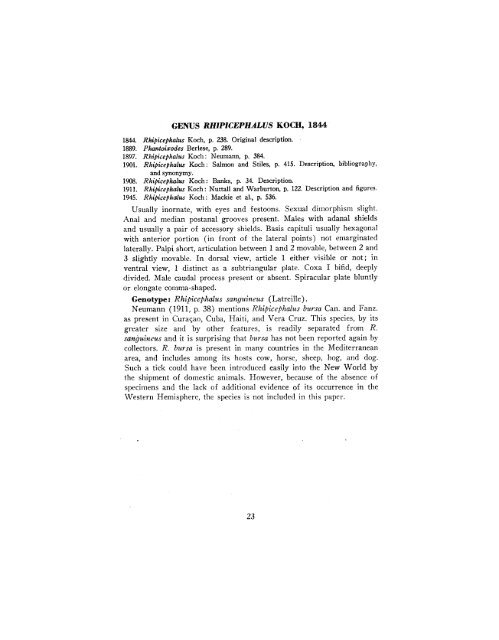The Genera Boophilus Rhipicephalus and Haemaphysalis (Ixodidae ...
The Genera Boophilus Rhipicephalus and Haemaphysalis (Ixodidae ...
The Genera Boophilus Rhipicephalus and Haemaphysalis (Ixodidae ...
You also want an ePaper? Increase the reach of your titles
YUMPU automatically turns print PDFs into web optimized ePapers that Google loves.
<strong>Rhipicephalus</strong> Koch, p. 238. Original description.<br />
1844.<br />
Phantoixodes Berlese, p. 289.<br />
1889.<br />
<strong>Rhipicephalus</strong> Koch: Neumann, p. 384.<br />
1897.<br />
<strong>Rhipicephalus</strong> Koch: Salmon <strong>and</strong> Stiles, p. 415. Description, bibliography,<br />
1901.<br />
synonymy.<br />
<strong>and</strong><br />
Rhipicephalua Koch: Banks, p. 34. Description.<br />
1908.<br />
Rhipicephcdus Koch: Nuttall <strong>and</strong> Warburton, p. 122. Description <strong>and</strong> figures.<br />
1911.<br />
Rhipicephclus Koch: Mackie et al., p. 536.<br />
1945.<br />
inornate, with eyes <strong>and</strong> festoons. Sexual dimorphism slight.<br />
Usually<br />
<strong>and</strong> median postanal grooves present. Males with adanal shields<br />
Anal<br />
anterior portion (in front of the :lateral points) not emarginated<br />
with<br />
Palpi short, articulation between 1 <strong>and</strong> 2 movable, between 2 <strong>and</strong><br />
laterally.<br />
slightly movable. In dorsal view, article 1 either visible or not; in<br />
3<br />
view, 1 distinct as a subtriangular plate. Coxa I bifid, deeply<br />
ventral<br />
Male caudal process present or absent. Spiracular plate bluntly<br />
divided.<br />
elongate comma-shaped.<br />
or<br />
(1911, p.<br />
Neumann<br />
present in Curacao, Cuba, Haiti, <strong>and</strong> Vera Cruz. This species,<br />
as<br />
size <strong>and</strong> by other features, is readily separated from R.<br />
greater<br />
<strong>and</strong> it is surprising that bursa has not been reported again by<br />
san#uineus<br />
R. bursa is present in many countries in the Mediterranean<br />
collectors.<br />
<strong>and</strong> includes among its hosts cow, horse, sheep, hog, <strong>and</strong> dog.<br />
area,<br />
a tick could have been introduced easily into the New World by<br />
Such<br />
shipment of domestic animals. However, because of the absence of<br />
the<br />
<strong>and</strong> the lack of additional evidence of its occurrence in the<br />
specimens<br />
Hemisphere, the species is not included in this paper.<br />
Western<br />
GENUS RHIPICEPHALUS KOCH, 1844<br />
<strong>and</strong> usually a pair of accessory shields.<br />
Basis capituli usually hexagonal<br />
Genotype: Rhipcephalus sanguineus<br />
(Latreille).<br />
38) mentions <strong>Rhipicephalus</strong> bursa Can. <strong>and</strong> Fanz.<br />
by its<br />
23

















